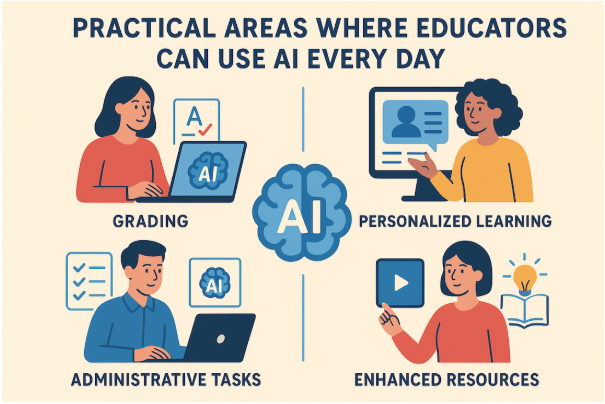
Let’s face it, teaching comes with a lot on your plate. From lesson planning to grading and keeping students engaged, the day can feel packed before it even starts. But what if you had a smart assistant by your side? That’s where AI comes in. You don’t need to be a tech expert to use it. In fact, there are simple, practical ways to bring AI into your routine and make things smoother. In this article, we’ll walk through eight everyday areas where you can use AI to save time and stay organized. Let’s get started.
Practical Applications of AI for Teachers
Let’s break down how teachers can actually use AI in the classroom. This isn’t just about futuristic tools. It’s about making daily tasks easier, saving time, and helping students learn better. Here’s how AI can support you in real, hands-on ways:
1. Lesson Planning and Curriculum Design
Planning lessons takes time, and aligning them with learning goals isn’t always easy. AI tools can step in here by helping you organise lessons and units according to curriculum
um standards. It can suggest the order in which to teach topics, how much time to spend on each, and even identify which areas might need more attention based on how your students are learning. If certain topics are tough for your class, AI can recommend extra practice activities or resources to support them.
2. Presentation and Slide Generation
Turning your lesson into a polished slideshow is now much simpler. With an AI presentation maker, you can quickly transform lesson content into clean, engaging slides. These tools can suggest layouts, add relevant visuals like charts or infographics, and make your presentations more interactive. This works well for both in-person classrooms and online or hybrid learning setups.
3. Multimedia and Visual Content Creation
AI can help you create videos, images, charts, and even animated diagrams to explain difficult concepts. Whether you’re teaching science, history, or geography, these tools can help you show things instead of just talking about them. You can also create virtual labs or simulations for a more hands-on experience.
4. Creating Quizzes and Practice Activities
Need a quick quiz or set of practice questions? AI can generate those in minutes. Whether it’s multiple-choice questions, short answers, or adaptive assessments that change based on student performance, these tools make it easier to track progress. Students can also get immediate feedback, which helps them learn from mistakes right away instead of waiting for the next class.
5. Personalized Learning and Adaptive Exercises
Every student learns differently. AI can personalise lessons by adjusting the content and pace for each learner. If someone is falling behind, the tool might offer simpler explanations or extra practice. For those who are ahead, it can suggest deeper challenges. This kind of tailored learning helps everyone progress more confidently and gives you insights into where each student stands.
6. Real-Time Feedback
One of the biggest perks of AI in education is instant feedback. Instead of waiting for you to check their work, students can get immediate feedback from AI tools. It highlights their mistakes and gives hints to guide them in the right direction. This helps keep them engaged and gives them a chance to improve on the spot.
7. Language and Communication Support
If you’re teaching English or working with second-language learners, AI can be incredibly helpful. It can offer grammar tips, pronunciation practice, vocabulary suggestions, and even sentence-building support. The exercises can be tailored to each student’s level. Some tools also suggest conversation prompts to improve speaking and listening skills in a more natural way.
8. Plagiarism Detection and Academic Integrity
Checking every assignment for copied content is tough. AI simplifies that by scanning essays, projects, and reports for plagiarism. It highlights areas that might be taken from other sources and suggests where citations are needed. This helps you teach students about originality and responsible writing, while also keeping academic standards in place.
Closing Thoughts
AI isn’t here to replace teachers. It’s here to help you manage the day-to-day tasks a little more easily. Whether it’s planning lessons, creating quizzes, or giving feedback, these tools can save time and reduce stress. Start with one or two areas that feel right for you. With small changes, you’ll start to see how AI can quietly support your work and help your students learn better.
About the Author
Anurag Bhagsain is the Founder of slidesai.io, where he leads the charge in transforming presentation design. With a love for blogging, Anurag uses his expertise to create informative content that educates and motivates. From sharing tips on effective storytelling to simplifying design concepts. Anurag is dedicated to empowering his audience to create compelling presentations. When he’s not immersed in blogging and presentations, Anurag enjoys coding & gaming.



